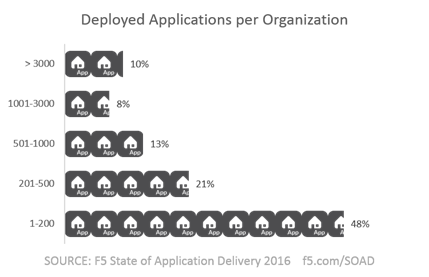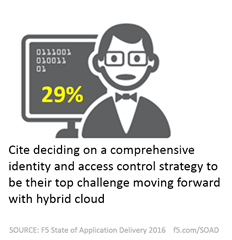État de la mise en œuvre des application 2016 : L'essor de l'accès aux identités et aux application
Autrefois, il y avait une relation quasi 1:1 entre les ports réseau et les applications. Port 53 ? C'est le DNS. Port 22? SSH. Port 23? Telnet. Port 80? C'est le site Web.
Notez le singulier, là. « Le » site web. Pas « l’une des deux cents applications Web fournies via HTTP ».
C’est une distinction importante, car elle permet de comprendre le déplacement du périmètre de l’application depuis la périphérie (le pare-feu du réseau) vers un endroit plus proche de l’application, à l’intérieur du centre de données (c’est le quartier intérieur pour ceux d’entre vous qui travaillent encore sur l’analogie du « château » pour la sécurité).

Nos dernières données montrent que 65 % des applications livrées sont basées sur HTTP. Les autres comprennent les suspects typiques : SSH, FTP, SMTP et DNS, entre autres protocoles peut-être moins connus. Et combien d’ applications existe-t-il dans une entreprise type ? Notre rapport sur l’état des livraisons application en 2016 en dit long. Près de la moitié ont entre 1 et 200 applications déployées. L'autre moitié ? Eh bien, plus de 200. Un chiffre assez surprenant : 10 % d’entre eux ont plus de 3 000 applications en cours d’exécution en ce moment.
Plus de la moitié de ces applications sont HTTP. Ils traversent tous le même port sur le fidèle défenseur du centre de données : le pare-feu réseau. Un pare-feu réseau qui, très probablement, ne peut pas faire la différence entre ces applications. Peu importe qu’il s’agisse de JSON ou de HTML, qu’il soit destiné à une entreprise ou à un consommateur, qu’il soit accessible depuis un appareil mobile pendant que vous êtes à la maison ou non.
Ceux-ci sont de plus en plus importants pour sécuriser les applications. Qu'il s'agisse de comprendre comment déterminer si la charge utile d'une application est compromise ou non (JSON n'est pas HTML ni XML) et si l'accès doit être autorisé ou non à partir d'un emplacement ou d'un appareil donné.

C'est le genre de questions qui préoccupent (bien plus qu'un iota) les services de contrôle d'accès aux application . Comme d’autres services liés aux applications , les services de contrôle d’accès aux application sont de plus en plus importants dans la stratégie de sécurité globale, précisément parce qu’ils peuvent différencier les applications et appliquer les politiques appropriées. Ils ne se contentent pas d'examiner les protocoles et les ports, ils fouillent en profondeur dans toute la conversation, évaluant une variété de variables (nous appelons cela le contexte) afin de décider si Bob devrait réellement être autorisé à accéder à cette application hautement sensible depuis son salon.
Les organisations en sont conscientes, selon nos recherches. 87 % ont déployé 4 services d’identité et d’accès ou plus aujourd’hui. Et sans surprise (du moins pour moi), c’est la catégorie de services d’application qui connaît la croissance la plus rapide en 2016, avec 50 % des entreprises prévoyant d’en déployer un dans les 12 prochains mois. Je dis sans surprise, car l’accès aux applications inclut aujourd’hui nécessairement le cloud, où les pare-feu réseau ne sont pas en mesure d’étendre le contrôle sur l’accès aux applications. Mais les services d’identité et d’accès le peuvent.
Il est vrai que les pare-feu réseau restent le service le plus déployé par les organisations, et je ne m’attends pas à ce que cela change de sitôt. Ils ont joué et continueront de jouer un rôle important dans la stratégie de sécurité de chaque organisation. Mais à mesure que le cloud, le mobile et l’Internet des objets continuent d’élargir le paysage des application qui doivent être protégées, nous allons continuer à voir une augmentation du rôle et de l’importance du contrôle d’accès aux application . Non seulement parce que les pare-feu réseau n'ont plus la visibilité nécessaire pour différencier les applications diffusées via le même protocole (HTTP), mais aussi parce qu'ils ne sont plus le seul point d'entrée dans ces applications lorsqu'un nombre important d'entre elles sont déployées dans le cloud.
Pour plus de détails, n'oubliez pas de consulter le rapport complet sur l'état de la distribution des application 2016.
